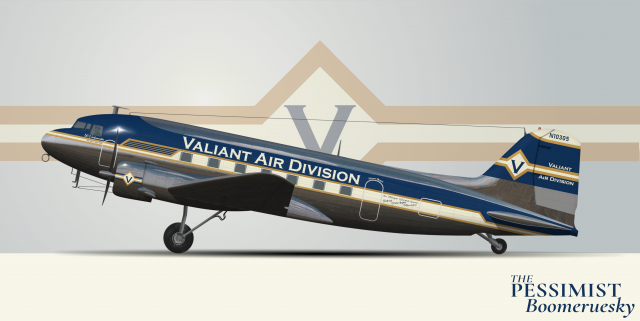
1940 Douglas DC-3
- Owner: ThePessimist (View all images and albums)
- Uploaded: Jan 19 2022 03:45 AM
- Views: 1,405
- Album Valiant Airways

Over its first seven years of existence, the Valiant Steamship Transportation Company's Air Division had turned a tidy profit with its flagship mail service. The endeavour was profitable and service was reliable enough that the company maintained its government contract. However, all was not well. The Great Crash came just over a year after Valiant Steamship Transportation Company’s (VSTC) first commercial flight. VSTC’s share price took a serious hit and the company experienced a cash crunch that endured for 4 years. The air service avoided destruction by being one of the highest profit segments of the company. VSTC’s traditional Great Lakes fleet was not as lucky and its size was slashed nearly in half as ships were laid up. There was no money nor interest in expanding the air service for the time being but it survived as a sort of ancillary part of the company whilst Winston Westbrook focused on bailing out the company’s primary operations.
The situation changed substantially when Winston Westbrook successfully lobbied American president Roosevelt and in 1933 secured a contract to supply certain projects undertaken by the newly created Public Works Administration in the Great Lakes region. The company established itself rather quickly to be reliable as a transporter of construction materials. In 1935, the Second New Deal created the Work Progress Administration and VSTC’s reputation with the Public Works Administration meant they had a foot in the door with new projects. Crucially, VSTC secured a role in engineering the expansion of the Soo Locks by way of the replacement of Weitzel Lock as well as a role as the primary vendor transporting materials to the worksite. This project was of considerable scale, enough so to boost company profits and keep a substantial portion of VSTC’s fleet in service. During the project, VSTC expanded and developed a substantial construction apparatus. This expansion led to the reorganization of VSTC into the Valiant Holding Group in late 1935.
Winston Westbrook remained CEO of the company through this transition. In 1938, the Valiant Holding Group (VHG) was approached by the Work Progress Administration (WPA) to take the lead on a new project. The WPA wanted to build a new terminal building at Milwaukee’s airport. VHG had established itself as a trusted construction partner for the WPA and given that they ran a scheduled service out of the airport, they were a natural choice. VHG signed a contract to build the new two-story terminal and an adjacent hotel for travellers employing WPA labourers. Some members of the board saw this project as an opportunity to increase the size of the company’s air division which had been renamed the Valiant Air Division. The Valiant Air Division (VAD) remained profitable after the name change and as crews on Great Lakes steamships became increasingly active, they began to use the mail service as a shuttle between the port hubs at Milwaukee, Grand Rapids, and Detroit. As the 30s wore on, an increasing number of mail service operators had inaugurated passenger service. Seeing the popularity of these early passenger air services and the convenience of the company’s own unofficial air route, members of the board thought that expanding VAD to service passenger routes would be a profitable enterprise. The new terminal in Milwaukee was a perfect spot upon which a small passenger network could be built.
The largest obstacle to the proposal was Winston Westbrook. His views of the aviation sector had not softened over time. Westbrook vehemently opposed passenger aviation operations. It took over a year of board meetings before the shareholders were able to build enough pressure on Westbrook to force the issue. It was a board meeting in 1939 that Westbrook was presented an ultimatum. Expand VAD or be replaced by someone who will. Westbrook was enraged, but was more concerned with maintaining his position than protecting consumers who he believed faced certain death if they were to regularly board an airplane. Thus, in 1939, Westbrook authorized the purchase of ten state-of-the art Douglass Commercial series 3 aircraft. By 1940, the first aircraft was delivered. These aircraft operated VAD’s first passenger service on the same route as the Lockheed Air Express had over a decade ago. However, unlike the previous mail contract, the company operated a small network of flights with a hub at the newly upgraded Milwaukee airport. This proverbial web of flights was one of the first “hub and spoke” networks in the region. The DC-3s were delivered in a very basic paint scheme. Westbrook had ordered the aircraft in a very basic, uniform livery. Crews who worked on various aircraft took up the task of adorning the fleet with finer details. Thus, all of VAD’s DC-3s looked roughly the same but were adorned with a wide variety of hand painted details. The service proved popular with passengers and cemented VAD as an enduring segment of VHG’s operations.
wow dat nice
ye ye ye
God damn this is nice. I love everything about this!
also 50000th comment in this Gallery section yay
Not anymore lmaoGod damn this is nice. I love everything about this!
also 50000th comment in this Gallery section yay
Nice!
nice
wow dat nice
ye ye ye
God damn this is nice. I love everything about this!
also 50000th comment in this Gallery section yay
Nice
Thanks y'all!
Link to PSD Template?
Gorgeous

 Sign In
Sign In Create Account
Create Account



















Nice!